Chickpeas, often overlooked in the realm of pantry staples, deserve a moment in the spotlight. These humble legumes, also known as garbanzo beans, pack a powerful punch when it comes to nutrition and culinary versatility. From their ancient origins in the Middle East to their widespread use in cuisines around the world, chickpeas have earned their place as a beloved ingredient in countless dishes.
So, let’s uncover the hidden potential of chickpeas and discover how they can elevate your meals from ordinary to extraordinary.
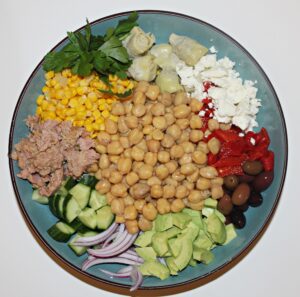
Health Benefits and Considerations
- Rich in Protein and Fiber: Chickpeas are an excellent source of plant-based protein, making them a great option for vegetarians and vegans. Additionally, they are packed with dietary fiber, which can aid in digestion, promote satiety, and support overall gut health.
- Heart Health: The high fiber content of chickpeas can help lower cholesterol levels and reduce the risk of heart disease. They are also rich in potassium, which helps regulate blood pressure and promote cardiovascular health.
- Blood Sugar Regulation: Chickpeas have a low glycemic index, meaning they cause a gradual rise in blood sugar levels. This can help stabilize blood sugar levels and prevent spikes and crashes, making them an excellent choice for individuals with diabetes or those looking to manage their blood sugar levels.
- Weight Management: Due to their high protein and fiber content, chickpeas can help promote feelings of fullness and satiety, which may aid in weight management and weight loss efforts.
- Nutrient Density: Chickpeas are packed with essential vitamins and minerals, including iron, magnesium, zinc, and B vitamins like folate and vitamin B6. These nutrients play crucial roles in various bodily functions, including energy metabolism, immune function, and red blood cell production.
While chickpeas offer numerous health benefits, it’s essential to consider potential considerations:
- Digestive Issues: Some individuals may experience digestive discomfort, such as gas or bloating, when consuming chickpeas, particularly if they are not used to consuming high-fiber foods. Soaking dried chickpeas before cooking and gradually increasing fiber intake can help mitigate these issues.
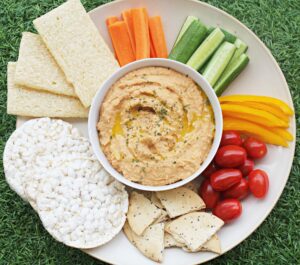
Chickpeas Beyond the Basics
- Roasted Chickpea Snacks: Transform chickpeas into a crunchy, addictive snack by roasting them with your favorite seasonings. Simply toss cooked chickpeas with olive oil, salt, and spices like paprika, cumin, or garlic powder, then roast in the oven until crispy. These roasted chickpeas make a satisfying and nutritious alternative to traditional snacks like chips or nuts.
- Chickpea Flour Creations: Chickpea flour, also known as gram flour or besan, is a gluten-free alternative that can be used in baking and cooking. Experiment with chickpea flour to make savory dishes like socca (a French chickpea pancake), pakoras (Indian fritters), or flatbreads. You can also use chickpea flour to add protein and texture to baked goods like pancakes, cookies, and muffins.
- Chickpea-Based Pasta: Embrace the trend of alternative pastas by trying chickpea-based pasta varieties. Made from a blend of chickpea flour and other plant-based ingredients, these pastas offer a gluten-free and protein-rich alternative to traditional wheat pasta. Serve chickpea pasta with your favorite sauces and toppings for a nutritious and satisfying meal.
- Sweet Treats with Chickpeas: Yes, chickpeas can even star in dessert! Puree cooked chickpeas with ingredients like cocoa powder, nut butter, and maple syrup to create a creamy and indulgent chocolate chickpea pudding. You can also use chickpeas as a base for healthy cookie dough or blondies. These sweet treats are a delicious way to sneak some extra protein and fiber into your diet.
So don’t be afraid to get creative and experiment with chickpeas in your cooking and baking adventures!
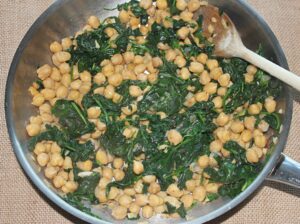
Tips for Cooking and Storing Chickpeas
Cooking chickpeas from scratch can be a rewarding experience, offering superior flavor and texture compared to canned varieties. Additionally, knowing how to properly store cooked and canned chickpeas can help extend their shelf life and maintain their freshness. Here are some tips for cooking and storing chickpeas:
- Cooking Dried Chickpeas:
- Rinse dried chickpeas under cold water and remove any debris or damaged beans.
- Soak the chickpeas overnight in a large bowl of water. This helps soften the beans and reduce cooking time.
- After soaking, drain and rinse the chickpeas again.
- Transfer the soaked chickpeas to a pot and cover them with fresh water. Bring the water to a boil, then reduce the heat and simmer, partially covered, until the chickpeas are tender. This typically takes about 1 to 1.5 hours, depending on the freshness of the beans.
- Once cooked, drain the chickpeas and rinse them under cold water. They are now ready to use in your favorite recipes or can be stored for later use.
- Storing Cooked Chickpeas:
- Cooked chickpeas can be stored in an airtight container in the refrigerator for up to 3 to 4 days. Make sure to let them cool completely before transferring them to the container.
- For longer storage, cooked chickpeas can be frozen. Spread them in a single layer on a baking sheet and freeze until solid, then transfer them to a freezer bag or container. Frozen chickpeas can last for up to 6 months in the freezer.
- Storing Canned Chickpeas:
- Canned chickpeas are a convenient pantry staple, but it’s essential to store them properly once opened.
- Transfer any unused canned chickpeas to a clean, airtight container and refrigerate them. They should be consumed within 3 to 4 days.
- If you prefer to use the entire can at once, you can also transfer the unused portion to a freezer-safe container and freeze them for later use.
Beans: Tiny Superfoods with Big Health Benefits
Cooking chickpeas in an Instant Pot
- Rinse and Sort: Start by rinsing the dried chickpeas under cold water and removing any debris or damaged beans.
- Soak (Optional): While soaking is not required, it can help reduce cooking time and improve digestibility. To soak chickpeas, cover them with water in a bowl and let them soak for at least 6 hours or overnight.
- Drain and Rinse: After soaking (if desired), drain and rinse the chickpeas thoroughly.
- Add to Instant Pot: Transfer the soaked or unsoaked chickpeas to the Instant Pot insert.
- Add Water or Broth: Add enough water or vegetable broth to cover the chickpeas by about 1 to 2 inches. For added flavor, you can also add aromatics like garlic cloves, onion halves, or bay leaves.
- Pressure Cook: Close the Instant Pot lid and set the valve to the sealing position. Select the “Pressure Cook” or “Manual” setting and set the cooking time:
- For soaked chickpeas: Cook on high pressure for 9 to 10 minutes.
- For unsoaked chickpeas: Cook on high pressure for 35 to 40 minutes.
- Natural Release: Once the cooking time is complete, allow the Instant Pot to naturally release the pressure for about 10 minutes. Then, carefully switch the valve to the venting position to release any remaining pressure.
- Drain and Serve: After the pressure has fully released, carefully open the Instant Pot lid. Drain the cooked chickpeas and use them in your favorite recipes.
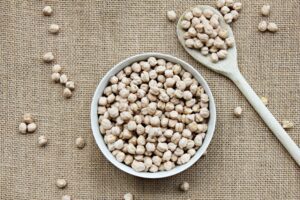
Tips to Incorporate Chickpeas Into the Diet
- Add Them to Salads for an extra boost of protein and fiber. They add a satisfying texture and help make your salads more filling and nutritious.
- Make Homemade Hummus using cooked chickpeas, tahini, garlic, lemon juice, and olive oil. Enjoy it as a dip for veggies, spread it on sandwiches or wraps, or use it as a flavorful topping for roasted vegetables.
- Create Chickpea Buddha Bowls by combining cooked chickpeas with grains like quinoa or brown rice, roasted or steamed vegetables, leafy greens, and your favorite sauces or dressings. Customize your bowls with additional toppings like avocado, nuts, seeds, or roasted sweet potatoes.
- Prepare Chickpea Curry or Stew: Whip up a hearty chickpea curry or stew using canned or cooked chickpeas, along with aromatic spices, tomatoes, coconut milk, and vegetables of your choice. Serve it over rice or with naan bread for a satisfying and flavorful meal.
- Roast Them for Snacks: Turn chickpeas into a crunchy and nutritious snack by roasting them with olive oil and your favorite seasonings. Enjoy them as a standalone snack or sprinkle them over salads and soups for added texture.
- Make Chickpea Burgers or Patties: Combine mashed chickpeas with breadcrumbs, herbs, spices, and binding ingredients like eggs or flaxseed meal. Form the mixture into patties and cook them on the stovetop or grill until golden brown.
- Bake With Chickpea Flour: Experiment with chickpea flour in your baking recipes to add a nutritious twist. Use chickpea flour as a gluten-free alternative in pancakes, muffins, cookies, and even pizza crusts for added protein and fiber.
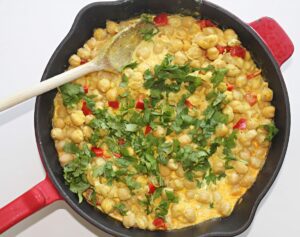
Delectable Recipes with Chickpeas
One-Pot Chickpea Stew with Vegetables
Chickpea Sandwich for Busy Mornings
Stuffed Sweet Potatoes with a Hint of Orange
A Flavorful Chickpea Patties Recipe
Potato Curry with Kale and Chickpeas
Pasta Salad Recipe with Roasted Butternut Squash
Sun-Dried Tomato Hummus Recipe
FAQ
Q1 Are chickpeas good for weight loss? Yes, chickpeas can be beneficial for weight loss due to their high fiber and protein content, which can help promote feelings of fullness and reduce overall calorie intake.
Q2 Are canned chickpeas as nutritious as dried chickpeas? Yes, canned chickpeas are still nutritious, although they may contain slightly more sodium due to the canning process. Look for low-sodium or no-salt-added varieties and rinse them thoroughly before using to reduce sodium content.
Q3 How should I store cooked chickpeas? Store in an airtight container in the refrigerator for 3 to 4 days. For longer storage, freeze them in a freezer-safe container or bag for up to 6 months.
Q4 Can I use chickpea flour as a substitute for wheat flour? Yes, chickpea flour can be used as a gluten-free alternative to wheat flour in many recipes, including pancakes, muffins, and flatbreads. However, it has a different texture and flavor, so adjustments may be needed in some recipes.
Q5 How can I reduce the gas-producing effects of chickpeas? Soaking dried chickpeas before cooking and rinsing canned chickpeas thoroughly can help reduce their gas-producing effects. Additionally, gradually increasing your intake of high-fiber foods like chickpeas can give your digestive system time to adjust.
More Articles to Read
How to Cook Beans in Instant Pot
Top 6 Super Seeds That Promote Optimal Health
Nutrition from Nature: 8 Healthiest Nuts You Should Be Eating
The Art of Pairing Fresh Herbs with Dishes
Culinary Medicine: The Healing Power of Spices
7 Secret Powers of Goji Berries
Buckwheat: The Ukrainian Superfood You Need





